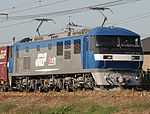JNR Class C51
| Class C51 | |
|---|---|
|
Class C51 locomotive C51 5 at Ome Railway Park, May 2006 | |
| Type and origin | |
| Reference:[1] | |
| Power type | Steam |
| Builder | Kisha Seizō, Mitsubishi, JNR - Hamamatsu |
| Build date | 1919-1928 |
| Total produced | 289 |
| Specifications | |
| Configuration | 4-6-2 Pacific |
| Gauge | 1,067 mm (3 ft 6 in) |
| Leading wheel diameter | 940 mm (3 ft 1 in) |
| Driver diameter | 1,750 mm (5 ft 9 in) |
| Trailing wheel diameter | 940 mm (3 ft 1 in) |
| Wheelbase | 10 m (32 ft 10 in) |
| Length | 19.994 m (65 ft 7.2 in) |
| Locomotive weight | 69.6 t |
| Locomotive and tender combined weight | 113.8 t |
| Fuel type | Coal |
| Fuel capacity | 8 t |
| Water capacity | 17 m3 (4,491 US gal) |
| Boiler pressure | 13 kg/cm2 (180 lbf/in2) |
| Firegrate area | 2.53 m2 (27 sq ft) |
| Heating surface: – Total | 127.4 m2 (1,371 sq ft) |
| Superheater area | 41.4 m2 (446 sq ft) |
| Cylinders | Two |
| Cylinder size | 53 cm × 66 cm (21 in × 26 in) |
| Valve gear | Walschaerts |
| Performance figures | |
| Maximum speed | 99.1 km/h (61.6 mph) |
The Class C51 (C51形) is a type of 4-6-2 steam locomotive built by Japanese National Railways (JNR). The C classification indicates three sets of driving wheels. The C51 introduced 1.75 m (5 ft 9 in) diameter driving wheels to Japan. C51s raised the average speed on the Tōkaidō Main Line from 47.3 km/h (29.4 mph) to 55.3 km/h (34.4 mph). In 1930, a C51 hauled the first Tsubame (swallow) express, reducing travel time between Tokyo and Kobe to 9 hours.[1]
Preserved examples
As of 2012, four Class C51 locomotives were preserved at various locations.
- C51 5: At the Railway Museum in Saitama, Saitama (formerly preserved outdoors at the Ome Railway Park in Ome, Tokyo[2]
- C51 44: At Akita Depot in Akita, Akita[2]
- C51 85: At Kagoshima Depot in Kagoshima, Kagoshima[2]
- C51 239: At the Umekoji Steam Locomotive Museum in Kyoto[2]
See also
References
| Wikimedia Commons has media related to C51 steam locomotives. |
| ||||||||||||||||
